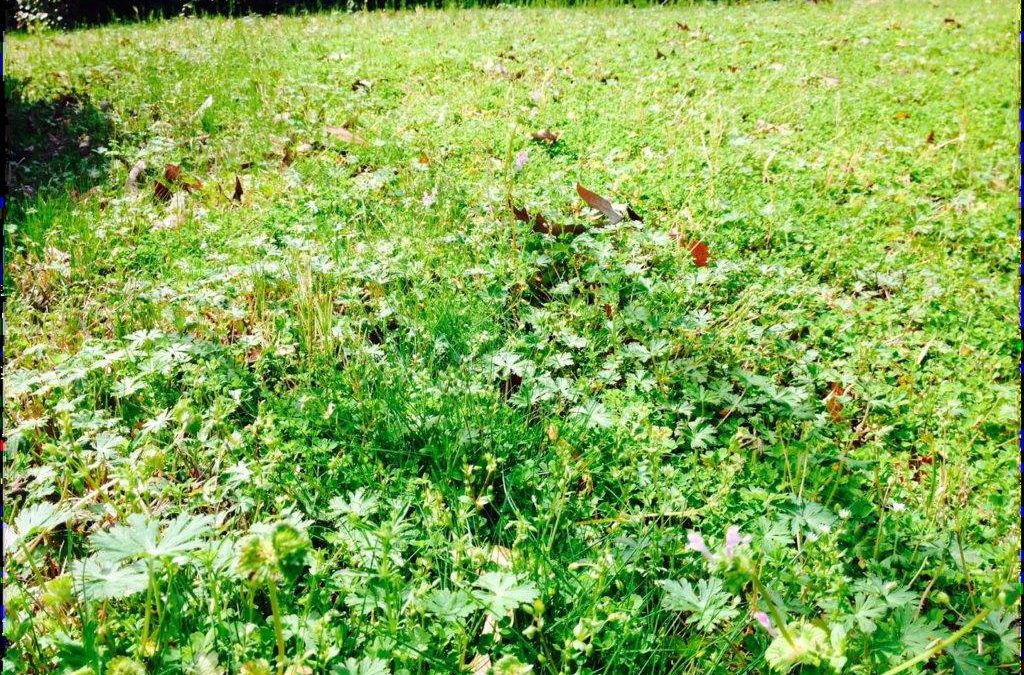
by Mark Tancig | Feb 11, 2021
Gardeners worldwide and throughout time have bemoaned weeds. In Florida, we get to enjoy weeds all year long! Our February Gardening in the Panhandle (GIP) Live episode focused on weeds and weed control. Many homeowners are interested in ways to control weeds and UF/IFAS Extension and your local extension agents are here to help. The following is a summary of the topics we discussed and links for more research-based information on weeds.
What is a Weed?
Many folks come to the extension office holding a plant and ask, “Is this a weed”? Well, whether it is a weed or not is up to the individual, as the only definition for a weed is “a plant out of place”. Bermudagrass and Oxalis are good examples of plants that some try to grow while others try to kill. One person’s weed is another’s wildflower! However, to be clear, plants classified as invasive by UF/IFAS and governmental entities are officially weeds. There are resources to help identify several common plants that are generally considered weeds by most homeowners and landscapers.
Weed ID Links
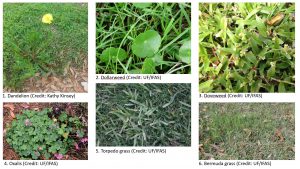
Common, and aggravating, weeds.
How to Prevent Weeds?
There are some general gardening practices that can help prevent weeds so there is less of a need to control them. A lawn that is healthy is less likely to be invaded by weeds and the use of mulch can greatly reduce weed growth in planting beds. Other practices, like the placement of weed fabrics/cloths are less effective and/or less practical in many garden situations.
Weed Prevention Links
How to Control Weeds?
Once you know and/or decide that what you have is a weed and that it needs to be dealt with, then you have to consider your control options. Prevention, as mentioned above, is key but sometimes you may need to use other methods of control, such as physical, mechanical, and/or chemical means. With chemical weed control, it is important to always read and follow the product label.
Weed Control Links
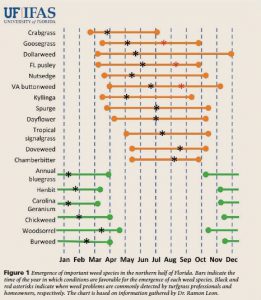
General dates of common annual weed emergence. Credit: Dr. Ramon Leon, UF/IFAS.
Specific Weed Recommendations
When managing pests, proper identification is key to effective control. Because some weeds are annuals, and present either during the cool or warm season, and others are perennials, proper weed identification can provide a more detailed control strategy. Use the weed ID links above and the document links below for more precise, and effective, weed management.
Species-Specific Control Links
If you need additional assistance with weed control, please contact your local county extension office. Please tune in for future GIP LIVE episodes for more research-based information on gardening topics.
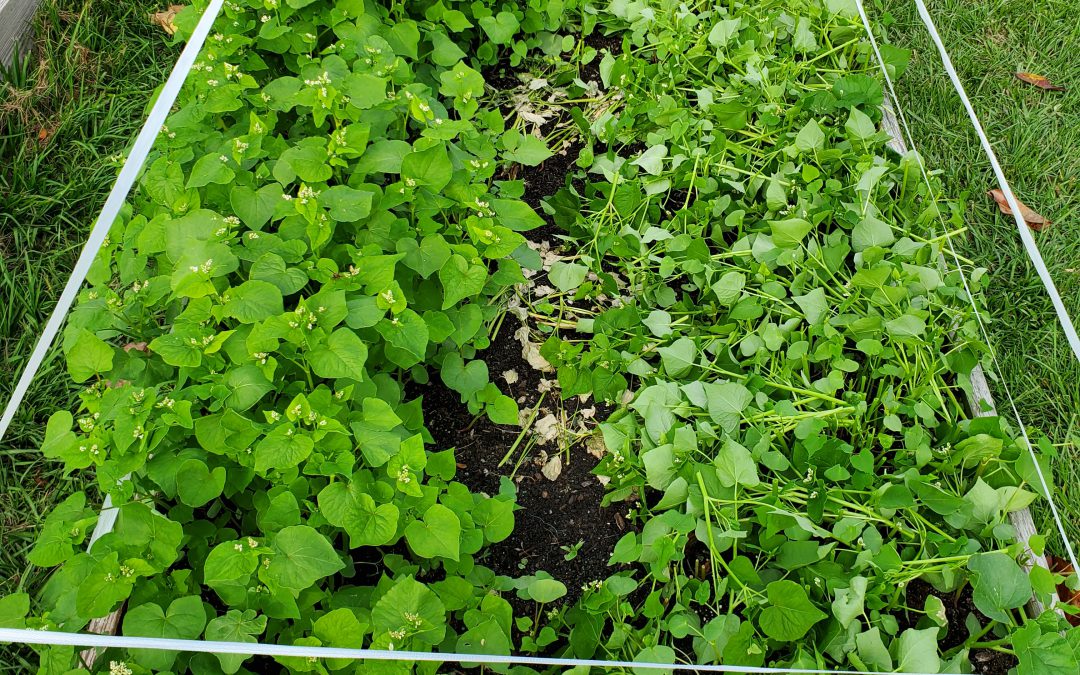
by Daniel J. Leonard | Sep 28, 2020
2020 has not been the most pleasant year in many ways. However, one positive experience I’ve had in my raised bed vegetable garden has been the use of a cover crop, Buckwheat (Fagopyrum esculentum)! Use of cover crops, a catch-all term for many species of plants used to “cover” field soil during fallow periods, became popular in agriculture over the last century as a method to protect and build soil in response to the massive wind erosion and cropland degradation event of the 1930s, the Dust Bowl. While wind erosion isn’t a big issue in raised bed gardens, cover crops, like Buckwheat, offer many other services to gardeners:
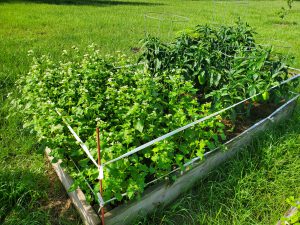
Buckwheat in flower behind summer squash. Photo courtesy of Daniel Leonard.
- Covers, like Buckwheat, provide valuable weed control by shading out the competition. Even after termination (the cutting down or otherwise killing of the cover crop plants and letting them decompose back into the soil as a mulch), Buckwheat continues to keep weeds away, like pinestraw in your landscape.
- Cover crops also build soil. This summer, I noticed that my raised beds didn’t “sink” as much as normal. In fact, I actually gained a little nutrient-rich organic matter! By having the Buckwheat shade the soil and then compost back into it, I mostly avoided the phenomena that causes soils high in organic matter, particularly ones exposed to the sun, to disappear over time due to breakdown by microorganisms.
- Many cover crops are awesome attractors of pollinators and beneficial insects. At any given time while my Buckwheat cover was flowering, I could spot several wasp species, various bees, flies, moths, true bugs, and even a butterfly or two hovering around the tiny white flowers sipping nectar.
- Covers are a lot prettier than bare soil and weeds! Where I would normally just have either exposed black compost or a healthy weed population to gaze upon, Buckwheat provided a quick bright green color blast that then became covered with non-stop white flowers. I’ll take that over bare soil any day.
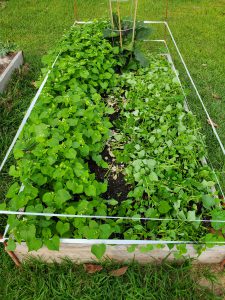
Buckwheat cover before termination (left) and after (right) interplanted with Eggplant. Photo courtesy Daniel Leonard, UF/IFAS Calhoun County Extension.
Now that I’ve convinced you of Buckwheat’s raised bed cover crop merits, let’s talk technical and learn how and when to grow it. Buckwheat seed is easily found and can be bought in nearly any quantity. I bought a one-pound bag online from Johnny’s Selected Seeds for my raised beds, but you can also purchase larger sizes up to 50 lb bags if you have a large area to cover. Buckwheat seed germinates quickly as soon as nights are warmer than 50 degrees F and can be cropped continuously until frost strikes in the fall. A general seeding rate of 2 or 3 lbs/1000 square feet (enough to cover about thirty 4’x8’ raised beds, it goes a long way!) will generate a thick cover. Simply extrapolate this out to 50-80 lbs/acre for larger garden sites. I scattered seeds over the top of my beds at the above rate and covered lightly with garden soil and obtained good results. Unlike other cover crops (I’m looking at you Crimson Clover) Buckwheat is very tolerant of imperfect planting depths. If you plant a little deep, it will generally still come up. A bonus, no additional fertilizer is required to grow a Buckwheat cover in the garden, the leftover nutrients from the previous vegetable crop will normally be sufficient!
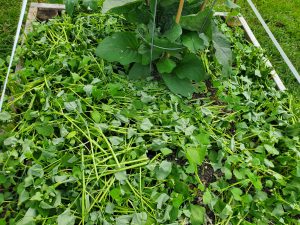
Buckwheat “mulch” after termination. Photo courtesy of Daniel Leonard, UF/IFAS Calhoun County Extension.
Past the usual cover crop benefits, the thing that makes Buckwheat stand out among its peers as a garden cover is its extremely rapid growth and short life span. From seed sowing to termination, a Buckwheat cover is only in the garden for 4-8 weeks, depending on what you want to use it for. After four weeks, you’ll have a quick, thick cover and subsequent mulch once terminated. After eight weeks or so, you’ll realize the plant’s full flowering and beneficial/pollinator insect attracting potential. This lends great flexibility as to when it can be planted. Have your winter greens quit on you but you’re not quite ready to set out tomatoes? Plant a quick Buckwheat cover! Yellow squash wilting in the heat of summer but it’s not quite time yet for the fall garden? Plant a Buckwheat cover and tend it the rest of the summer! Followed spacing guidelines and only planted three Eggplant transplants in a 4’x8’ raised bed and have lots of open space for weeds to grow until the Eggplant fills in? Plant a Buckwheat cover and terminate before it begins to compete with the Eggplant!
If a soil building, weed suppressing, beneficial insect attracting, gorgeous cover crop for those fallow garden spots sounds like something you might like, plant a little Buckwheat! For more information on Buckwheat, cover crops, or any other gardening topic, contact your local UF/IFAS County Extension Office. Happy Gardening!
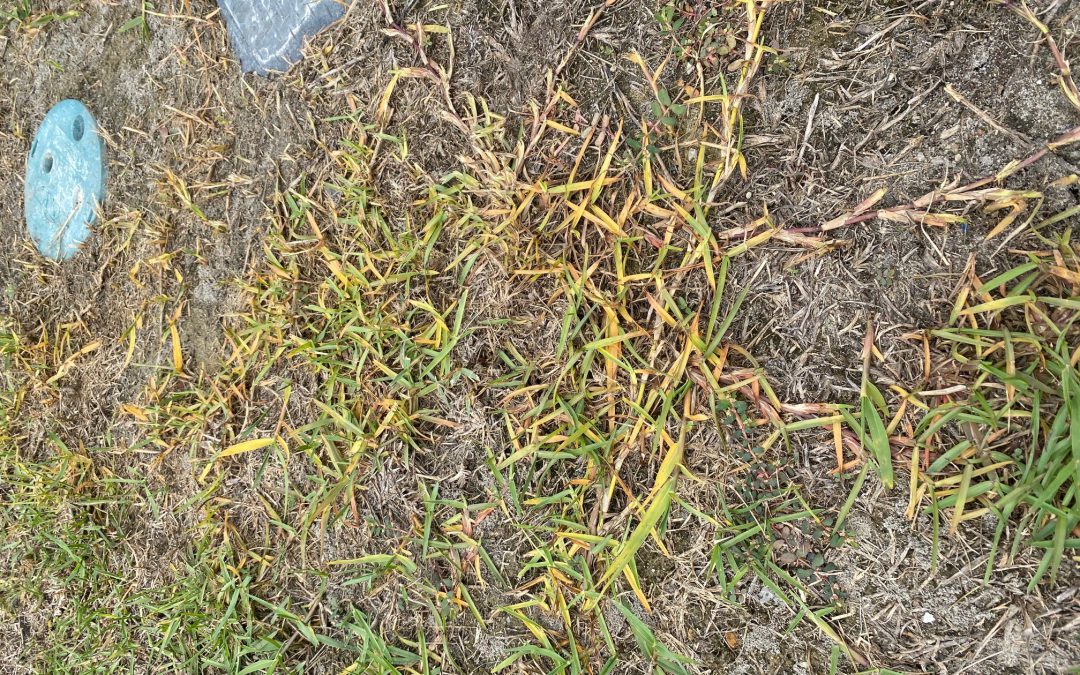
by Julie McConnell | Sep 28, 2020
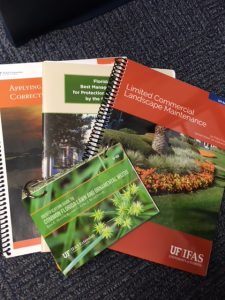 Earlier this summer I talked about getting to know your weeds, so they’ll be easier to control. If you missed that article you can review it here “Why Can’t I Kill Weeds?”
Earlier this summer I talked about getting to know your weeds, so they’ll be easier to control. If you missed that article you can review it here “Why Can’t I Kill Weeds?”
Today we will look at the types of herbicides available so your selection will fit your situation.
Understand your herbicide options. Picking out the appropriate herbicide can be overwhelming. The options seem unlimited when you are standing in the store looking at aisles of containers. By preparing yourself before you shop you can save time and increase your chances of making the most effective selection. Here are some herbicide basics:
- Label interpretation. The pesticide label is a multipage document that describes ingredients, how a pesticide works, application instructions, safety requirements, and other important information for the user. Before applying any pesticide (yes, herbicides are pesticides!) you should read the entire label. Pulling the label off the package in the store may be frowned upon and the print is very small. For this reason, I would recommend looking up a few options before you go shopping and reading the labels online. This allows you to take your time to be sure you understand if it is the appropriate product and you can make your shopping list for personal protective and application equipment before you leave the house. Three important things to look for when selecting your product are active ingredient, labeled site (site includes the location such as residential landscape vs. agricultural crops and the plants it is safe to use on), and targeted pest.
-
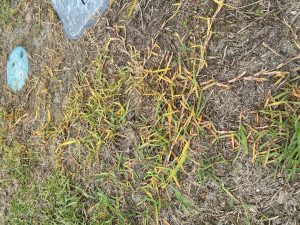
Non-selective, systemic herbicide damage on grass. Photo: J_McConnell, UF/IFAS
Pre-emergent herbicides. Pre-emergent herbicides provide control when applied BEFORE seed germination of your target weed. They do not prevent germination, rather they prevent emergence of shoots and roots essentially inhibiting normal plant growth which eventually results in plant death. It is important to have your product in place during the correct window of time. Typically, 1-2 weeks before germination of your target weed is ideal.
- For warm season annual weeds (crabgrass, goosegrass, sandspur, and spurge are examples) apply pre-emergent herbicides when day temperatures in early spring reach 65-70°F for 4-5 consecutive days. This may be mid-February or as early as January.
- For winter annual weeds (henbit, black medic, geranium, and chickweed are examples) watch for night temperatures in the Fall to reach 55-60°F for several nights in a row to indicate proper application timing.
- Some products are selective to plant types such as grasses, sedges or broadleaf weeds. Other products are more broad-spectrum and are effective on multiple weed types.
- Pre-emergent herbicide should not be used if you intend to plant seed – it will affect your desired plant in addition to the weed! There may also be effects on newly planted lawns or plants, so be sure to read the label closely to avoid damage to non-target plants.
- Post-emergent herbicides. These products are used on weeds that have already emerged, regardless of life cycle (annual, perennial, biennial). This type of herbicide will be applied directly to the weed you are trying to kill. There are a few categories within this group.
- Selective or non-selective.
Selective herbicides work on particular categories of plants: broadleaf, sedge, grass, or woody plant.
Non-selective herbicides can kill any type of plant regardless of category.
- Contact or systemic.
Contact herbicides kill the plant tissue it comes into contact with and does not translocate to the rest of the plant.
Systemic herbicides are translocated throughout the plant to affect more than just the place of absorption. These are ideal for perennial weeds that would regenerate from roots, bulbs, or tubers if the top is damaged or killed.
Effective weed management requires some preparation and research for the best outcome. For help with weed identification and control recommendations, contact your local UF/IFAS Extension Office.
Further reading on weeds and herbicides:
Florida Homeowner Herbicide Guide: Considerations, Applications, and Selection
Postemergent Herbicides for Use in Ornamentals
Weed Management Guide for Florida Lawns
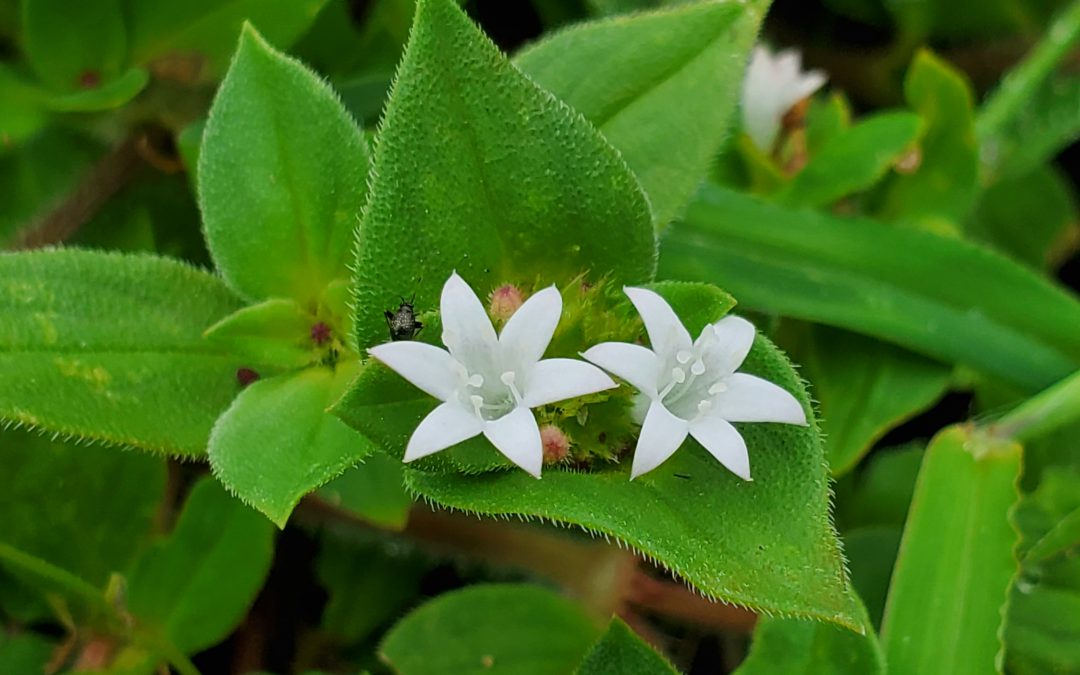
by Evan Anderson | Sep 14, 2020
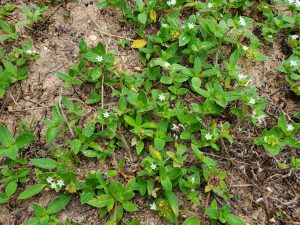
Florida pusley has a low, spreading habit.
Florida pusley and its relatives, Brazilian and large-flower pusley, are common sights in lawns and landscapes during the summer. These prolific and tenacious weeds are closely related species in the genus Richardia, in the Rubiaceae family which includes coffee, bedstraw, and the plant from which the emetic ipecac is derived. With their thick leaves, low and spreading growing habit, and bright white flowers, they can quickly take over bare spots in a lawn and become quite a nuisance.
Because bare spots are a magnet for pusley (and weeds in general), one method to help prevent this weed from becoming a problem is to ensure the turfgrass is as healthy as possible. Well established grass can outcompete many other competitors. Keeping a lawn in tip-top shape includes watering properly, mowing at the recommended height for the grass species and variety, fertilizing appropriately, and controlling pests and diseases in a timely fashion. This can take some work in North Florida’s hot, humid climate, but prevention is almost always easier than trying to cure a problem.
Florida pusley is quickly noticed as soon as it flowers. While some may find the flowers attractive, they set seeds swiftly and before you know it, the next generation of plants is ready to go. Surprisingly, they are also an important nectar plant for honeybees. If chemical control is warranted for an infestation, a pre-emergent herbicide may help. Timing is important for this, so keep an eye on the thermometer – pre-emergents should be applied in the spring (February or March) when temperatures reach 65-70 degrees Fahrenheit for four to five days in a row. Examples are products with active ingredients such as atrazine or pendimethalin, though atrazine should not be used on bermudagrass or bahiagrass.
For weed problems that are already established, there are post-emergent herbicides available. In bahia, bermuda, and zoysia, products containing 2,4-D (or mixtures, such as 2,4-D and dicamba) can work fairly well. These products may require two applications to adequately control pusley. Be aware that some herbicides are sold under trade names that may be confusing, such as Roundup for Southern Lawns, which is a mixture of 2,4-D and penoxsulam, and is labeled for use on bahia, bermuda, St. Augustine, and zoysia grasses . It does not contain glyphosate, and Roundup that DOES contain glyphosate will kill turfgrass as well as weeds. Check the active ingredients on the herbicide label.
In St. Augustine lawns, options are more limited. Homeowners with St. Augustine may want to consider contacting a lawn care company for help with pusley. The available herbicides that are labeled for use in this instance are either difficult to use or prohibitively expensive (The herbicide Celsius, for example, costs over $100 per 10 oz. bottle). Another chemical that is effective is metsulfuron, and while it can be used in bermuda and zoysia lawns as well, it comes with some serious difficulties. First and foremost, it can be taken up by the roots of plants and is NOT safe to use around trees or shrubs. Properly measuring the chemical is tricky, as it may take only a single ounce to treat a whole acre. Serious damage can be done to surrounding plants if it is mixed or used improperly, and as such it may be difficult to find at local stores.
Homeowners who choose an herbicide to control pusley or any weed should be aware that high temperatures during the Florida summer can cause chemicals to affect the grass as well. St. Augustine is especially prone to this, and some herbicides such as 2,4-D may affect grasses more when temperatures rise above 85-90 degrees Fahrenheit.
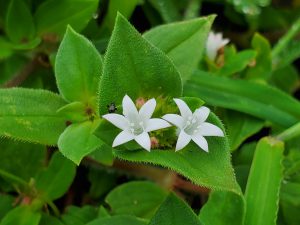
A closeup of Florida pusley flowers.
Treatment of pusley and weeds in general is most effective when the plants are young. Large pusley plants have deeper roots and may take more applications of herbicides to control effectively. Furthermore, of the pusley species that can be found in our area, large-flower pusley is more difficult to control and may be tolerant of some chemicals. For more information, contact your local Extension office.
-Evan Anderson, Walton County Horticulture Agent
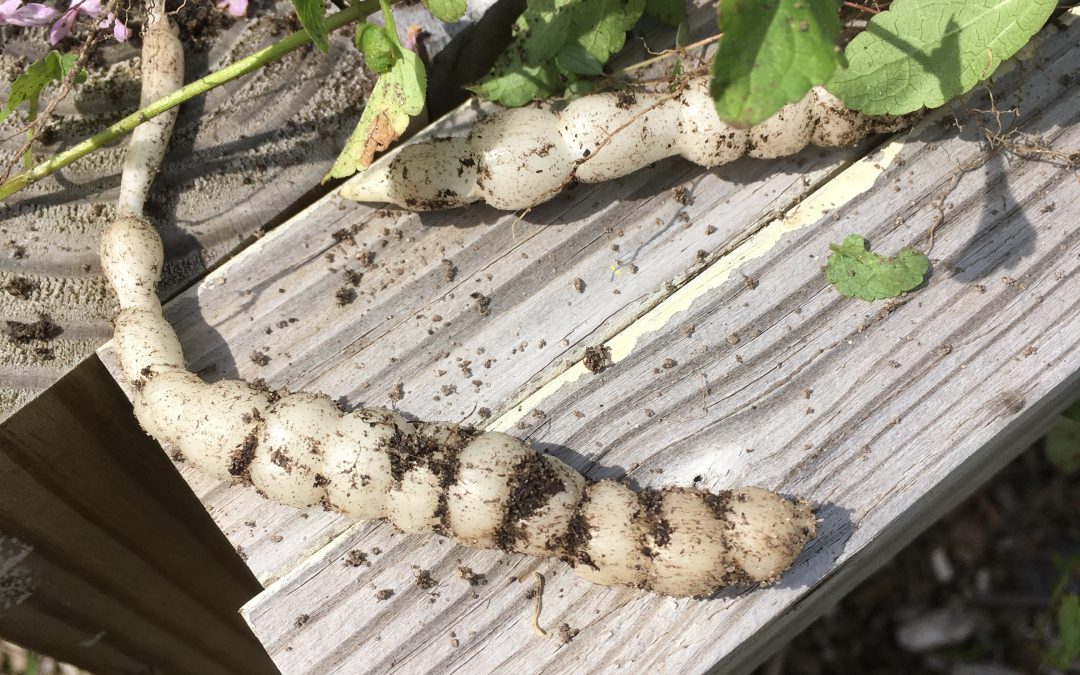
by Julie McConnell | Jun 11, 2020
Why are the plants we are trying not to grow so hard to kill? Weeds can be quite frustrating to home gardeners as they struggle to get them under control. There are a few things you can do to help make your efforts more successful.
Identify the weed. It might seem like it doesn’t matter what the plant is if you know you want to get rid of it, but a big part of your strategy should be figuring out why that plant is being so difficult. Below are the reasons why weed identification is so critical in your fight to control it.
- Which plant are you favoring with your maintenance routine? All plants have similar basic needs: water, sunlight, nutrients, and a space to grow, but some perform better with varying amounts of each of these inputs. Sometimes we can influence these factors in a way that favors one plant over another. The best example is how we irrigate our landscape. If you plant drought tolerant shrubs, such as Indian Hawthorne, which can survive with little to no irrigation after establishment, and then continue to water 2-3 times a week, is it any wonder that you get water loving weeds such as dollarweed, torpedograss, or sedge? Only apply inputs that support your desirable plants and nothing more.
- Recognize the weed type. There are three main types of weeds we typically encounter: broadleaf, grass, or sedge. Some herbicides are broad-spectrum, which means they kill any type of plant, while others are selective. Selective herbicides generally target either broadleaf, grass or sedge weeds and have minimal impact on the other types. This can be very important information to have if you are shopping for an herbicide.
- Understand the life cycle. Herbaceous plants fall into three main life cycle categories: annual, perennial, or biennial. Annuals and biennials tend to reproduce primarily from seed. The annual plant completes its entire life cycle in one season or year and a biennial takes two years. When targeting these two, your goal is to get rid of the plant before it flowers and sets seed to reduce future crops. If you miss that window and the weeds go to seed, plan to use a pre-emergent herbicide prior to their next scheduled germination date (usually the next season). Perennials live for more than 2 years and tend to be tough to manage. They may reproduce by seed but many also multiply by vegetative means. To put this simply, they store everything they need in tiny pieces of the plant and if left in place, it will generate more plants. So, that little tiny root fragment from dollar weed you didn’t pull up – yep, it’ll grow a whole new one in its place!
For more information on weeds and weed control in lawns and landscapes, contact your local UF/IFAS County Extension Office!















